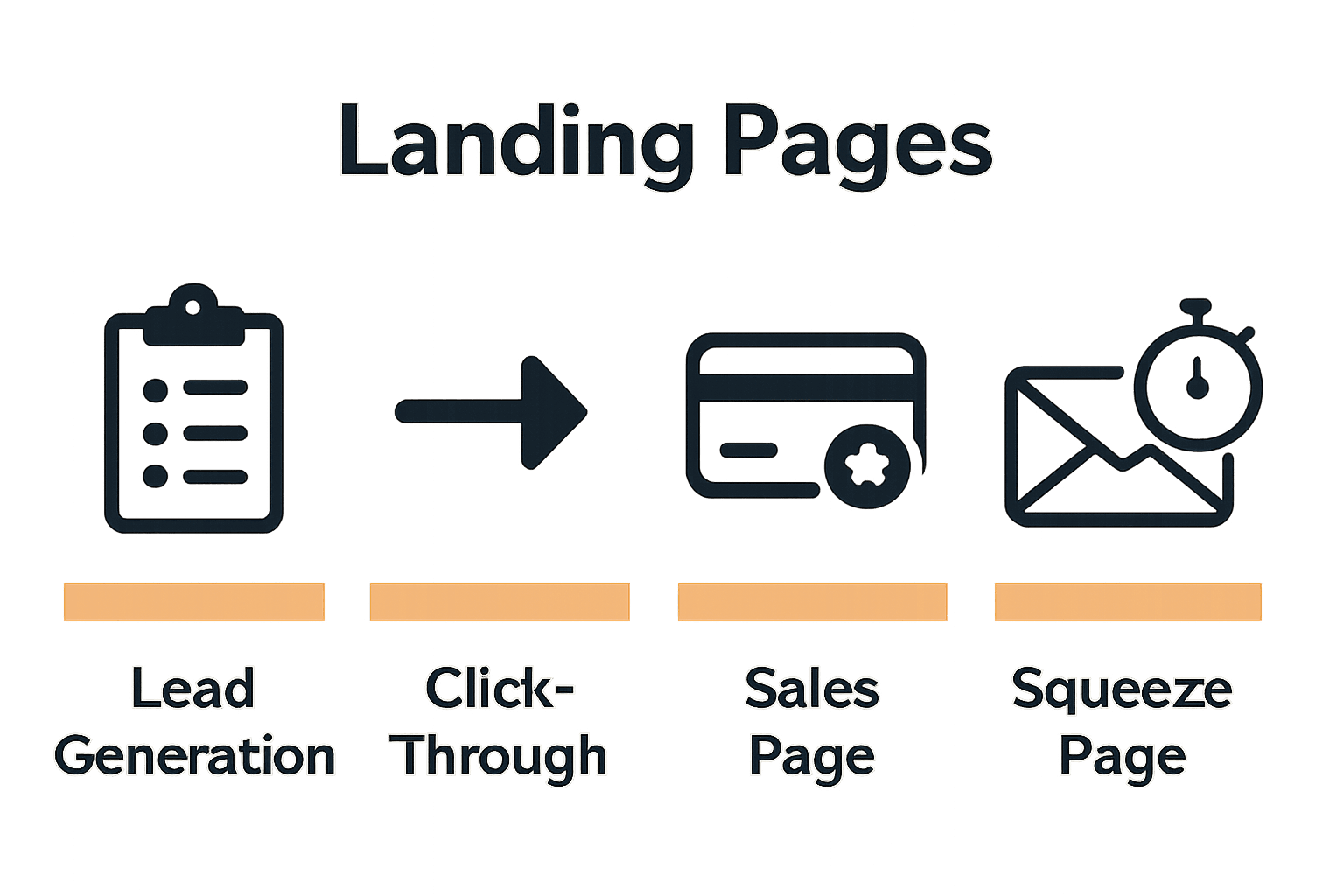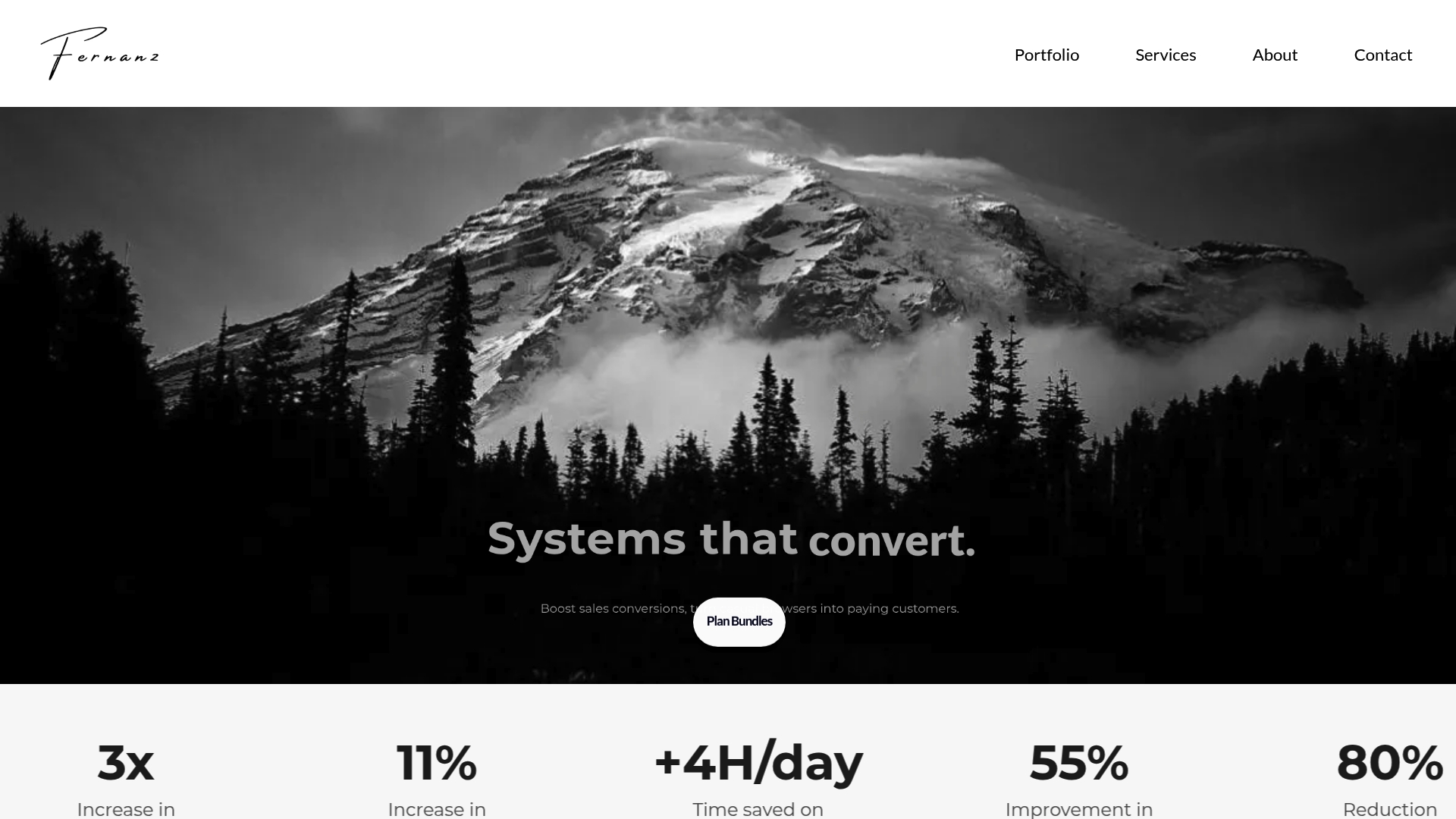
Complete Guide to the Role of Landing Pages
Complete Guide to the Role of Landing Pages
Did you know that landing pages can increase conversion rates by up to 300 percent when built correctly? For any business that relies on web traffic, understanding how these focused pages drive action is crucial. A well-designed landing page not only attracts attention, it turns visitors into loyal customers by delivering the right message at the perfect moment.
Key Takeaways
Point Details
Focus on Conversion Landing pages should have a singular goal to convert visitors, utilizing clear calls-to-action and benefit-oriented content.
Understand Your Audience Tailoring the messaging and design of landing pages to meet the specific needs and desires of the target audience is crucial for success.
Leverage Automation Integrating landing pages with automated systems can enhance lead nurturing and optimize conversion rates through personalized experiences.
Avoid Common Mistakes Minimizing design complexity, ensuring fast load times, and aligning messaging are essential to prevent performance pitfalls on landing pages.
Table of Contents
Understanding Landing Pages and Their Purpose
A landing page is a specialized web page with one laser-focused mission: convert visitors into leads or customers. Unlike traditional website pages that offer multiple navigation paths, landing pages are strategically designed to guide visitors toward a single, specific
Landing pages typically include several critical components that drive conversions:
High-quality visuals that capture attention
A crystal-clear call-to-action (CTA) that stands out
Benefit-oriented content explaining value propositions
Social proof like testimonials or client results
Concise, straightforward form design
Mobile-responsive layout for seamless experience
According to digital marketing research, well-crafted landing pages can significantly increase conversion rates by focusing visitor attention and reducing distractions. By removing site-wide navigation and presenting a singular, compelling offer, businesses create a streamlined path for potential customers to take immediate action. The key is understanding your target audience's specific needs and designing an experience that speaks directly to their desires and pain points.
For entrepreneurs and business owners seeking scalable growth, landing pages represent a powerful tool in your digital marketing arsenal. They transform casual website traffic into qualified leads and potential sales opportunities, acting as a strategic bridge between marketing efforts and actual business results.
Types of Landing Pages and Key Differences
Businesses leverage different landing page types to achieve specific marketing objectives, each designed with a unique strategic purpose. Learn more about targeted traffic conversion to optimize your approach. The primary landing page categories include:
Lead Generation Landing Pages: Focused on collecting visitor contact information through forms, typically offering valuable content like e-books, webinars, or industry reports in exchange for email addresses
Click-Through Landing Pages: Designed to warm up potential customers and pre-sell a product, often used in e-commerce to bridge awareness and purchase decision
Sales Pages: Comprehensive pages dedicated to directly selling a product or service, featuring detailed value propositions, pricing, and compelling calls-to-action
Squeeze Pages: Minimal design pages with a single goal of capturing email addresses, using minimal distractions and strong psychological triggers
Each landing page type requires a nuanced approach tailored to specific audience segments and conversion goals. Successful implementations recognize that one-size-fits-all strategies rarely work in digital marketing. The most effective landing pages align closely with the visitor's stage in the buying journey, presenting precisely the right information at the right moment.
For entrepreneurs and growth-focused businesses, understanding these landing page variations is crucial.

By strategically selecting and designing landing pages that match your specific marketing objectives, you can transform casual web traffic into qualified leads and accelerate your sales pipeline. The key is precision targeting, compelling value communication, and removing friction from the conversion process.
Here's a comparison of the main types of landing pages:

Core Elements That Maximize Conversions
Transforming website visitors into committed customers requires strategic conversion optimization that goes beyond simple design. Learn more about high-ticket sales strategies to enhance your approach. The most effective landing pages integrate several critical elements that create an irresistible user experience:
Compelling Headline: Immediately communicates unique value proposition
Clear and Concise Copy: Explains benefits with razor-sharp precision
Powerful Call-to-Action (CTA): Uses action-oriented language that creates urgency
Social Proof: Incorporates testimonials, case studies, and credibility markers
Visual Hierarchy: Guides visitor attention through strategic design elements
Minimal Form Fields: Reduces friction in conversion process
Mobile Responsiveness: Ensures seamless experience across all devices
The psychology of conversion revolves around reducing perceived risk and increasing perceived value. Successful landing pages create an environment of trust by demonstrating expertise, showcasing tangible results, and making the next step feel both simple and compelling. This means crafting an experience that speaks directly to the visitor's specific pain points and offers a clear, low-resistance path to solving their problem.
For entrepreneurs and growth-focused businesses, conversion optimization is not about manipulation but about genuine communication. By aligning your landing page's messaging, design, and user experience with your ideal customer's deepest needs and desires, you transform casual interest into committed action. The magic happens when visitors feel understood, supported, and confident in taking the next step with your business.
Integrating Landing Pages With Automated Systems
Marketing automation transforms landing pages from static web elements into dynamic, intelligent conversion machines. Explore our product marketing solutions to unlock full potential. The integration of landing pages with automated systems enables businesses to create sophisticated, responsive marketing ecosystems that adapt in real-time to user behavior.
Key automation integration strategies include:
Intelligent Lead Routing: Automatically categorizing and directing leads based on interaction signals
Dynamic Content Personalization: Adjusting page elements based on visitor demographics and previous interactions
Automated Follow-up Sequences: Triggering email campaigns, SMS, or retargeting ads instantly after landing page engagement
Real-time Analytics Tracking: Monitoring user behavior and conversion metrics to continuously optimize performance
CRM Synchronization: Seamlessly transferring lead data across marketing and sales platforms
Successful automation goes beyond technical implementation. It requires a deep understanding of your customer's journey, creating interconnected touchpoints that feel personalized and frictionless. By leveraging machine learning and intelligent workflows, businesses can create landing pages that not only capture leads but nurture them through sophisticated, automated communication strategies.
For growth-minded entrepreneurs, integrating landing pages with automated systems represents the future of efficient marketing. These intelligent systems work continuously, qualifying leads, personalizing experiences, and driving conversions even when you're not actively managing them. The result is a scalable, predictable revenue generation mechanism that adapts and improves with every interaction.
Common Mistakes That Undermine Performance
Landing page optimization requires precision and strategic thinking. Discover our high-ticket sales optimization techniques to avoid critical pitfalls that drain your marketing resources. Entrepreneurs frequently stumble into performance-killing traps that significantly reduce conversion potential.
The most common landing page mistakes include:
Overcomplicated Design: Overwhelming visitors with too many visual elements or complex navigation
Weak Value Proposition: Failing to clearly communicate unique benefits within seconds
Misaligned Messaging: Creating disconnects between ad copy, landing page content, and audience expectations
Slow Page Load Times: Losing potential customers due to technical performance issues
Ineffective Call-to-Action: Using vague, uninspiring, or poorly positioned conversion triggers
Lack of Social Proof: Neglecting to include credible testimonials, case studies, or trust signals
Non-Responsive Design: Ignoring mobile user experience and optimization
Successful landing pages operate like precision instruments. Each element must work harmoniously to guide visitors toward a specific conversion goal. The most destructive mistake is treating landing pages as generic web pages rather than strategic conversion tools. This means every visual, every word, and every design choice must be intentionally crafted to address your ideal customer's specific needs and psychological triggers.
For growth-focused businesses, avoiding these common mistakes isn't just about preventing losses—it's about creating a competitive advantage. By developing landing pages that are clear, compelling, and conversion-focused, you transform potential friction points into smooth, irresistible pathways that guide visitors exactly where you want them to go.
Bridge the Gap Between High-Intent Visitors and Lasting Revenue Growth
You have carefully crafted your landing pages to guide prospects toward action, but are you truly unlocking their full conversion power? Many leaders in B2B and high-ticket sectors struggle to translate website traffic into consistent sales because their systems remain isolated or manual. As discussed in our guide, maximizing conversion means addressing every stage of the visitor journey—from sharp headlines and smart automation to seamless CRM integration and follow-up. Yet, most businesses still face bottlenecks in aligning those pieces for a measurable increase in both qualified leads and long-term revenue.
With Fernanz, you do not have to settle for a fragmented approach. Our Product Marketing solutions are built specifically for organizations who want to automate, unify, and scale their customer acquisition strategy. We combine bespoke website redesigns with AI-powered lead qualification and tightly integrated marketing tech stacks, so your landing pages do more than just capture emails—they drive sales while you focus on growing your business.

Are you ready to finally turn landing page insights into a single, automated revenue engine? See how our team at Fernanz supports ambitious companies like yours with end-to-end system integration, data-driven conversions, and proven case studies. Let us help your business optimize every visitor touchpoint today. Visit our homepage now and start building a smarter, high-converting digital presence.
Frequently Asked Questions
What is the purpose of a landing page?
A landing page is designed with a singular mission to convert visitors into leads or customers by guiding them toward a specific action without distractions.
What are the main types of landing pages?
The main types of landing pages include lead generation landing pages, click-through landing pages, sales pages, and squeeze pages, each serving a unique strategic purpose within marketing efforts.
How can I maximize conversions on my landing page?
To maximize conversions, focus on elements like a compelling headline, clear and concise copy, strong calls-to-action, social proof, and a mobile-responsive design. Reduce friction by minimizing form fields and ensuring a seamless user experience.
What common mistakes should I avoid when creating a landing page?
Common mistakes include overly complicated designs, weak value propositions, misaligned messaging, slow load times, ineffective calls-to-action, lack of social proof, and non-responsive layouts. Avoiding these can enhance your landing page performance.
